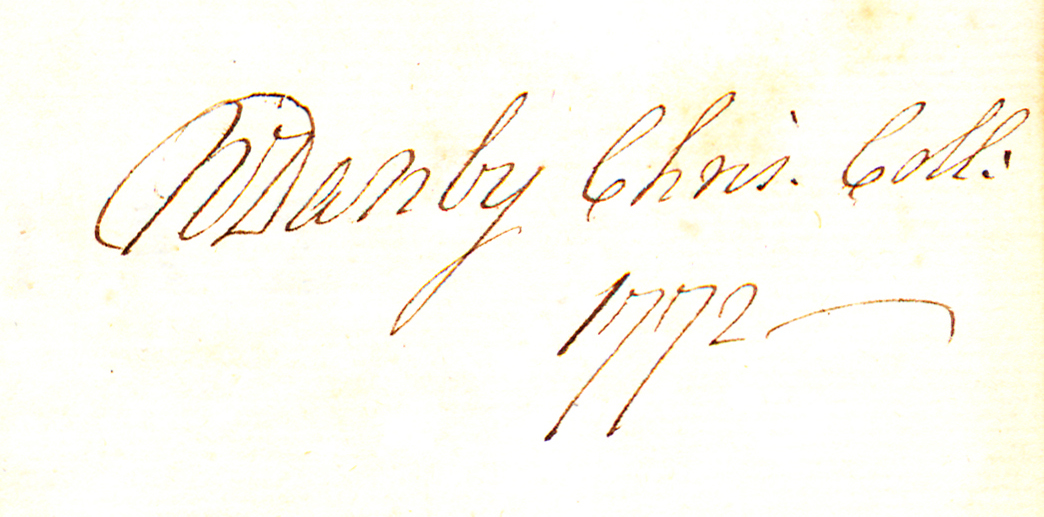Tēs tou Homērou Odysseias
Της του Όμήρου Ίλιάδος ό τόμος πρότρος Δεγτερος
by Homer
| Tēs tou Homērou Odysseias | |
|
Title page from Tēs tou Homērou Odysseias, George Wythe Collection, Wolf Law Library, College of William & Mary. | |
| Author | Homer |
| Editor | James Moor and George Muirhead |
| Published | Glasguae:: In aedibus Academicis, Excudebant R. et A. Foulis |
| Date | 1758 |
| Language | Greek |
| Volumes | 2 volumes in 1 volume set |
| Desc. | Folio (34 cm.) |
Little is known about the life of Homer. Even in Greek antiquity, no one knew anything for certain about the poet responsible for the Iliad and the Odyssey. Herodotus claimed he lived around 850 BCE, while modern scholars usually date his poems to the second half of the eighth century BCE.[1] The Trojan War is estimated to have occurred at the end of the Mycenaean Age in Greece, around 1200 BCE, meaning that Homer was looking back over 400 years to a heroic world much greater (in his esteem) than the contemporary world. Homer had to rely on a combination of evidence from the oral tradition in order to compose his poems, which provides some of the basis for the “separatist” view that the two epic poems were not written by the same person or perhaps were not written by just one poet at all but a combination of poets. It still cannot be proven whether both poems were written by the same person (scholars have spent entire careers trying to prove their view), but it is generally accepted that each poem can be attributed to a single person, whether that poet is one in the same or not. Regardless, the mixed dialect of Ionian Greek that each poem is originally written in indicates that both poems were written in the east Aegean. This is supported by contextual clues in the poems themselves. The two most plausible locations for the birth of Homer are Smyrna and Chios, but ancient Greeks viewed the poet as a blind minstrel wandering while he composed his epic poems which were sung or chanted to an accompaniment by the poet on a lyre. One can see from this, the similarity between the wanderings of Odysseus and Homer.[2]
Homer’s Odyssey is an epic poem consisting of 24 books telling the story of the Trojan War hero Odysseus’s ten year journey trying to get home to his wife Penelope and son Telemachus in Ithaca, where he is king. This epic is distinct from the Iliad for, even though it refers to a Trojan War character, it is a more romantic rather than heroic/tragic poem. It is very clear in the Odyssey who the “good” and “bad” characters are, and therefore who the readers (or more accurately as it was intended to be recited orally, the listeners) should be rooting for Odysseus is shown through much of Greek mythological writing as an intelligent and crafty individual: first tricking Achilles into agreeing to join the Greeks against the Trojans and secondly tricking the Trojans with the giant wooden horse which ended the war. In the Odyssey, Odysseus’s familial devotion, general intelligence, and his "eternal human quality[y] of resolution" contrast with the barbaric creatures he meets on his adventures, as well as with the suitors attempting to woo his wife.[3] Odysseus’s supreme human qualities served as an example to Greek men of idyllic behavior, just as Penelope’s devotion to her husband and home showed Greek women how to behave. Furthermore, these two characters were used throughout European literature to exemplify ideal behavior. The strong moral themes through the Odyssey in no way take away from the exciting adventures Odysseus encountered from the Cyclopes to the Lotus Eaters to the Sirens to tricking and slaughtering his wife’s suitors.
Evidence for Inclusion in Wythe's Library
Listed in the Jefferson Inventory of Wythe's Library as "[Homeri] Odysseus. Gr. 2.v. fol. Foulis" and given by Thomas Jefferson to Dabney Carr. Both the Brown Bibliography[4] and George Wythe's Library[5] on LibraryThing list the 1758 Greek version of the Odyssey published by the Foulis Press. The Wolf Law Library purchased the same edition.
Description of the Wolf Law Library's copy
Bound in contemporary full diced brown calf with wide gilt tooled borders and five gilt stamped raised bands. Spines feature gilt lettered and elaborately gilt decorated and ornamented compartments. The edges are gilt-rolled. Includes the bookplates of William Danby, Lytton Strachey, and Roger Senhouse on the front pastedown. Signature "W Danby, Chris. Coll. 1772" on front flyleaf. Part of a combined set with Tēs tou Homērou Iliados. Purchased from David Brass.
References
- ↑ "Homer” in The Oxford Companion to Classical Literature, ed. by M.C. Howatson (Oxford: Oxford University Press, 2011).
- ↑ Ibid.
- ↑ "Homer" in Oxford Dictionary of the Classical World.
- ↑ Bennie Brown, "The Library of George Wythe of Williamsburg and Richmond," (unpublished manuscript, May, 2012) Microsoft Word file. Earlier edition available at: https://digitalarchive.wm.edu/handle/10288/13433
- ↑ LibraryThing, s. v. "Member: George Wythe," accessed on June 27, 2013, http://www.librarything.com/profile/GeorgeWythe




